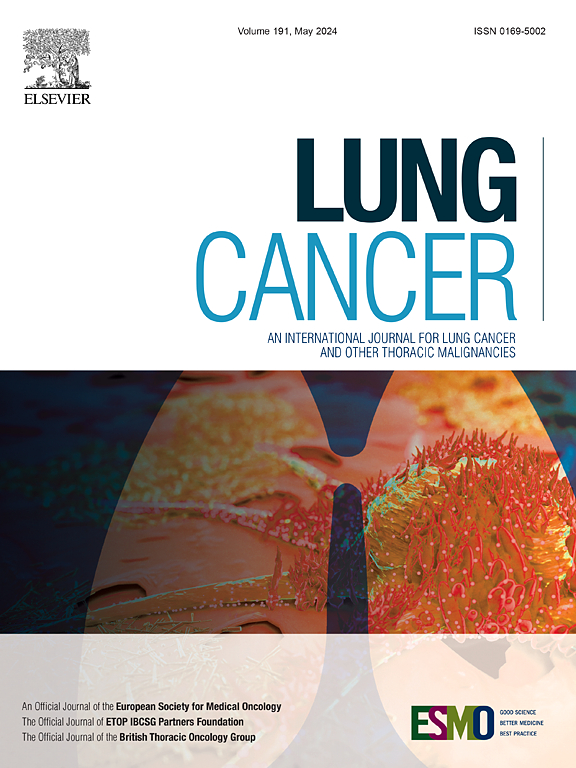手术治疗肺癌的发展趋势:16年医院流行病学分析
IF 4.4
2区 医学
Q1 ONCOLOGY
引用次数: 0
摘要
目的探讨手术治疗肺癌患者临床流行病学特征的纵向趋势,并评估预防策略的意义。方法回顾性分析2006-2021年复旦大学上海肿瘤中心确诊并手术治疗的肺癌患者。收集社会人口统计学、临床和病理数据。连续和分类数据变量分别采用非参数检验和卡方检验进行分析,趋势分析采用线性回归。结果共纳入21743例患者,中位年龄59岁,其中11802例(54.3%)为女性。从2006年到2021年,女性比例从29.9%上升到59.5%,与此同时,45岁的患者比例从6.2%上升到15.4%,年轻女性从3.4%上升到19.2%。非吸烟者占主导地位(2021年为72.0%,2006年为42.3%),尤其是女性(不吸烟者为97.5%),女性不吸烟者的总体比例从26.8%增加到58.5%。在女性中,腺癌的患病率从51.7%上升到82.9%,而鳞状癌的患病率则从31.0%下降到4.1%。早期诊断(0-I期)从37.1%增加到85.0%,与健康检查驱动的检出率从44.0%增加到70.5%相一致。腺癌中EGFR突变率在女性(69.4%)和非吸烟者(68.9%)中明显较高。结论不吸烟者比例的上升、年轻女性肺癌发病率的上升、早期肺癌病例的增加以及主要病理亚型的转变,为中国肺癌防治带来了潜在的挑战和方向。年轻非吸烟女性肺癌的出现及其潜在因素值得进一步研究。本文章由计算机程序翻译,如有差异,请以英文原文为准。

Evolving Trends in Surgically Managed Lung Cancer: A 16-Year Hospital-Based Epidemiological Analysis
Purpose
To investigate longitudinal trends in clinical-epidemiological characteristics among surgically treated lung cancer patients and assess implications for prevention strategies.
Methods
A retrospective analysis was conducted on patients diagnosed with lung cancer and surgically treated at Fudan University Shanghai Cancer Center (2006–2021). Socio-demographics, clinical and pathological data were collected. Continuous and categorical data variables were analyzed using non-parametric tests and chi-square tests, respectively, with trend analysis conducted by linear regression.
Results
A total of 21,743 patients with a median age of 59 were included of whom 11,802 (54.3 %) were women. From 2006 to 2021, the female proportion surged from 29.9 % to 59.5 %, paralleled by an increase in patients aged < 45 years (6.2 % to 15.4 %), with young females rising from 3.4 % to 19.2 %. Non-smokers predominated (72.0 % in 2021 vs. 42.3 % in 2006), particularly among women (97.5 % non-smokers), and the overall proportion of female non-smokers increased from 26.8 % to 58.5 %. Adenocarcinoma prevalence increased from 51.7 % to 82.9 % in females, while squamous carcinoma declined from 31.0 % to 4.1 %. Early-stage diagnoses (Stage 0-I) increased from 37.1 % to 85.0 %, coinciding with health checkup-driven detection rising from 44.0 % to 70.5 %. The EGFR mutation rate in adenocarcinoma was notably high in females (69.4 %) and non-smokers (68.9 %).
Conclusions
The rising percentage of non-smokers, growing incidence of lung cancer among young females, increase in early-stage lung cancer cases, and shift in major pathological subtypes present potential challenges and directions for lung cancer prevention and control in China. The emergence of lung cancer in young non-smoking females and its underlying factors warrant further research.
求助全文
通过发布文献求助,成功后即可免费获取论文全文。
去求助
来源期刊

Lung Cancer
医学-呼吸系统
CiteScore
9.40
自引率
3.80%
发文量
407
审稿时长
25 days
期刊介绍:
Lung Cancer is an international publication covering the clinical, translational and basic science of malignancies of the lung and chest region.Original research articles, early reports, review articles, editorials and correspondence covering the prevention, epidemiology and etiology, basic biology, pathology, clinical assessment, surgery, chemotherapy, radiotherapy, combined treatment modalities, other treatment modalities and outcomes of lung cancer are welcome.
 求助内容:
求助内容: 应助结果提醒方式:
应助结果提醒方式:


